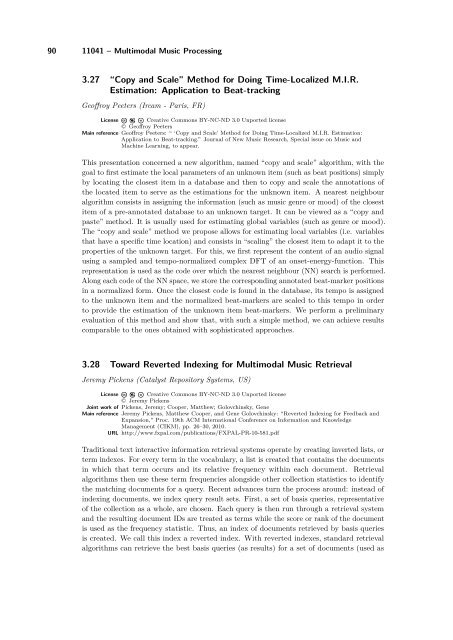Volume 1, Issue 1, January 2011 - DROPS - Schloss Dagstuhl
Volume 1, Issue 1, January 2011 - DROPS - Schloss Dagstuhl
Volume 1, Issue 1, January 2011 - DROPS - Schloss Dagstuhl
Create successful ePaper yourself
Turn your PDF publications into a flip-book with our unique Google optimized e-Paper software.
90 11041 – Multimodal Music Processing<br />
3.27 “Copy and Scale” Method for Doing Time-Localized M.I.R.<br />
Estimation: Application to Beat-tracking<br />
Geoffroy Peeters (Ircam - Paris, FR)<br />
License Creative Commons BY-NC-ND 3.0 Unported license<br />
© Geoffroy Peeters<br />
Main reference Geoffroy Peeters: “ ‘Copy and Scale’ Method for Doing Time-Localized M.I.R. Estimation:<br />
Application to Beat-tracking.” Journal of New Music Research, Special issue on Music and<br />
Machine Learning, to appear.<br />
This presentation concerned a new algorithm, named “copy and scale” algorithm, with the<br />
goal to first estimate the local parameters of an unknown item (such as beat positions) simply<br />
by locating the closest item in a database and then to copy and scale the annotations of<br />
the located item to serve as the estimations for the unknown item. A nearest neighbour<br />
algorithm consists in assigning the information (such as music genre or mood) of the closest<br />
item of a pre-annotated database to an unknown target. It can be viewed as a “copy and<br />
paste” method. It is usually used for estimating global variables (such as genre or mood).<br />
The “copy and scale” method we propose allows for estimating local variables (i.e. variables<br />
that have a specific time location) and consists in “scaling” the closest item to adapt it to the<br />
properties of the unknown target. For this, we first represent the content of an audio signal<br />
using a sampled and tempo-normalized complex DFT of an onset-energy-function. This<br />
representation is used as the code over which the nearest neighbour (NN) search is performed.<br />
Along each code of the NN space, we store the corresponding annotated beat-marker positions<br />
in a normalized form. Once the closest code is found in the database, its tempo is assigned<br />
to the unknown item and the normalized beat-markers are scaled to this tempo in order<br />
to provide the estimation of the unknown item beat-markers. We perform a preliminary<br />
evaluation of this method and show that, with such a simple method, we can achieve results<br />
comparable to the ones obtained with sophisticated approaches.<br />
3.28 Toward Reverted Indexing for Multimodal Music Retrieval<br />
Jeremy Pickens (Catalyst Repository Systems, US)<br />
License Creative Commons BY-NC-ND 3.0 Unported license<br />
© Jeremy Pickens<br />
Joint work of Pickens, Jeremy; Cooper, Matthew; Golovchinsky, Gene<br />
Main reference Jeremy Pickens, Matthew Cooper, and Gene Golovchinsky: “Reverted Indexing for Feedback and<br />
Expansion,” Proc. 19th ACM International Conference on Information and Knowledge<br />
Management (CIKM), pp. 26–30, 2010.<br />
URL http://www.fxpal.com/publications/FXPAL-PR-10-581.pdf<br />
Traditional text interactive information retrieval systems operate by creating inverted lists, or<br />
term indexes. For every term in the vocabulary, a list is created that contains the documents<br />
in which that term occurs and its relative frequency within each document. Retrieval<br />
algorithms then use these term frequencies alongside other collection statistics to identify<br />
the matching documents for a query. Recent advances turn the process around: instead of<br />
indexing documents, we index query result sets. First, a set of basis queries, representative<br />
of the collection as a whole, are chosen. Each query is then run through a retrieval system<br />
and the resulting document IDs are treated as terms while the score or rank of the document<br />
is used as the frequency statistic. Thus, an index of documents retrieved by basis queries<br />
is created. We call this index a reverted index. With reverted indexes, standard retrieval<br />
algorithms can retrieve the best basis queries (as results) for a set of documents (used as













